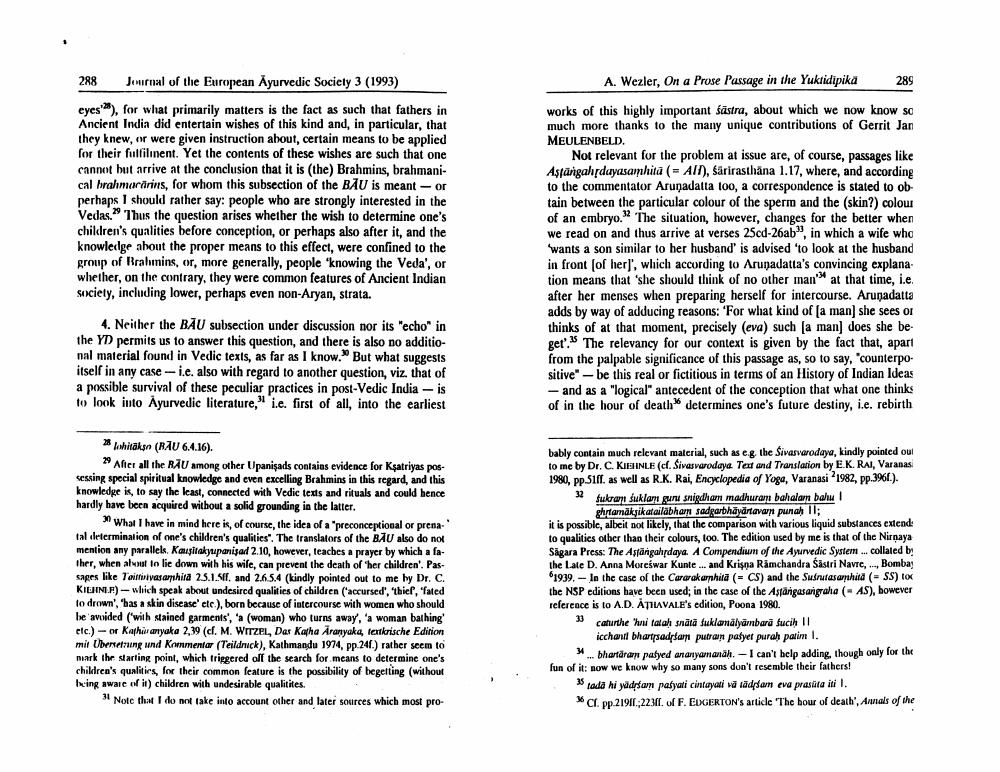________________
288
Journal of the European Ayurvedic Society 3 (1993)
A. Wezler, On a Prose Passage in the Yuklidipika
289
eyes), for what primarily matters is the fact as such that fathers in Ancient India did entertain wishes of this kind and, in particular, that
ey knew, or were given instruction about, certain means to be applied for their fulfilment. Yet the contents of these wishes are such that one cannot but arrive at the conclusion that it is (the) Brahmins, brahmanical brahmanirins, for whom this subsection of the BAU is meant or perhaps I should rather say: people who are strongly interested in the Vedas. Thus the question arises whether the wish to determine one's children's qualities before conception, or perhaps also after it, and the knowledge about the proper means to this effect, were confined to the group of Rralumins, or, more generally, people knowing the Veda', or whether, on the contrary, they were common features of Ancient Indian society, including lower, perhaps even non-Aryan, strata.
works of this highly important sastra, about which we now know so much more thanks to the many unique contributions of Gerrit Jan MEULENBELD.
Not relevant for the problem at issue are, of course, passages like Asfärgahduyasamhita (AIT), Särirasthana 1.17, where, and according to the commentator Arunadalta loo, a correspondence is stated to obtain between the particular colour of the sperm and the (skin?) colour of an embryo. The situation, however, changes for the better when we read on and thus arrive at verses 25cd-26ab", in which a wife who 'wants a son similar to her husband' is advised to look at the husband in front of her]', which according to Arunadatta's convincing explana tion means that she should think of no other man at that time, i.e. after her menses when preparing herself for intercourse. Arunadatta adds by way of adducing reasons: "For what kind of (a man] she sees or thinks of at that moment, precisely (eva) such (a man] does she beget'. The relevancy for our context is given by the fact that, apart from the palpable significance of this passage as, so to say, "counterpo sitive" - be this real or fictitious in terms of an History of Indian Ideas - and as a "logical" antecedent of the conception that what one thinks of in the hour of death determines one's future destiny, i.e. rebirth
4. Neither the BAU subsection under discussion nor its "echo" in the YD permits us to answer this question, and there is also no additional material found in Vedic texts, as far as I know. But what suggests itself in any casei.e. also with regard to another question, viz. that of a possible survival of these peculiar practices in post-Vedic India - is to look into Ayurvedic literature," i.e. first of all, into the earliest
Whitaksn (RAU 6.4.16).
29 After all the RAU among other Upanişads contains evidence for Ksatriyas possessing special spiritual knowledge and even excelling Brahmins in this regard, and this knowledge is, to say the least, connected with Vedic texts and rituals and could hence hardly have been acquired without a solid grounding in the latter.
What I have in mind here is, of course, the idea of a preconceptional or prena. tal determination of one's children's qualities. The translators of the BAU also do not mention any parallel. Kausitakyupanijad 2.10, however, teaches a prayer by which a fa. ther, when alust to lie down with his wife, can prevent the death of her children'. Passages like Taittoriyasanhita 25.1.Sef. and 2.6.54 (kindly pointed out to me by Dr. C. KICHINI.F) - which speak about undesired qualities of children (accursed', 'thier, faled to drown', 'bas a skin disease' etc), born because of intercourse with women who should he wided with stained garments', '* (woman) who turns away, 'a woman bathing etc.) or kahinyaka 2,39 (d. M. WITZEL, Dar Katha Aranyaka, letrische Edition mir Ubersetzung und Kommentar (Teildnick), Kathmandu 1974, pp.241.) rather seem to niark the starting point, which triggered off the search for means to determine one's children's qualities, for their common feature is the possibility of begelling (without heing aware of it) children with undesirable qualities.
Note that I do not take into account other and later sources which most pro
bably contain much relevant material, such as er the Sivasvarodaya, kindly pointed out to me by Dr. C. K INLE (cf. Sivasyodaya. Text and Translation by E.K. RAI, Varanas 1980, pp. 511, as well as R.K. Rai, Encyclopedia of Yoga, Varanasi 1982, pp.3961.). u fukran suklam guru snigdham madhuram bahalar bahu
phytadkikatailabham sadgabháydavan punah 11; it is possible, albeit not likely, that the comparison with various liquid substances extende to qualities other than their colours, too. The edition used by me is that of the Nirnaya Sigara Press: The Asfangahrdaya. A Compendium of the Ayurvedic System. collated by the Lale D. Anna Moriwar Kunte ... and Krisna Ramchandra Sastri Navre, Bombay 61939.- In the case of the Carerakahita ( CS) and the Sufrufasahia (SS) tox the NSP editions have been used in the case of the A pesar praha (-AS), bowever reference is to A.D. ATIVALE's edition, Poona 1980.
» caturthehuni tatah snáta fuklanälyumbara Sucih 11
icchant bhartsadefar putran palyet purah palim I.
... bhartaran payed ananyamanah. - I can't help adding, though only for the fun of it: now we know why so many sons don't resemble their fathers!
tada ni yadpan payati cintayari adysan eva prasita iti I. ar pp.21916:22311. of F. EDGERTON's article 'The hour of death', Annals of the




